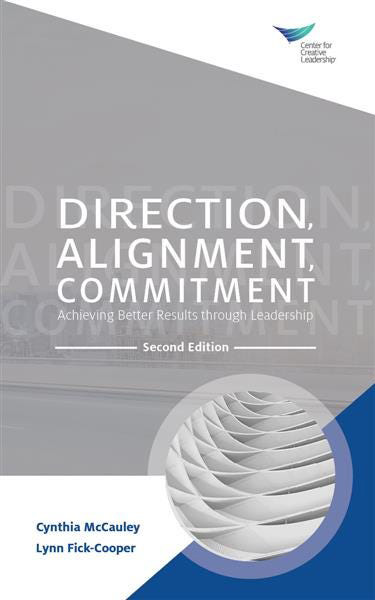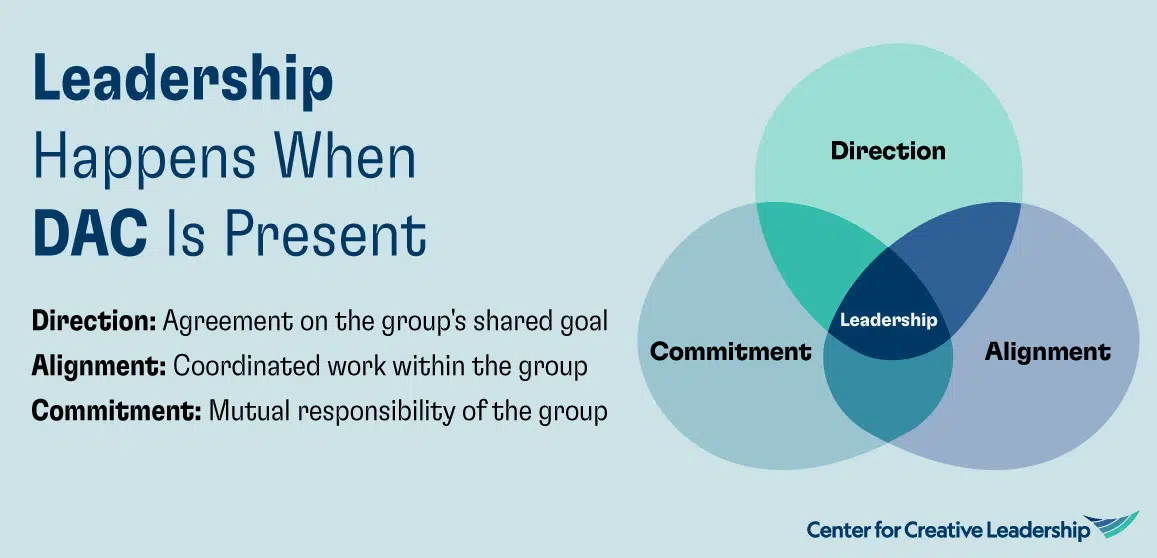What Is DAC? The DAC Model for Leadership, Explained
Whether within a team, workgroup, task force, division, department, community, or an entire organization, there must be a clear sense of shared direction, alignment, and commitment. The group needs:
- agreement about its direction and what they are trying to accomplish together;
- alignment for effective coordination of the work in service of their shared direction; and
- strong commitment to prioritize the success of the collective.
These 3 outcomes of leadership in the DAC model — direction, alignment, and commitment — make it possible for individuals to work together willingly and effectively to realize organizational achievements. So when we say making leadership happen, we mean making direction, alignment, and commitment happen.
In fact, we think the only way to know if leadership has happened is to look for the presence of these 3 outcomes.
But there isn’t “a” single leader making leadership happen.
Don’t get us wrong — we aren’t abandoning the importance of leadership development and individual managers examining and further developing their talents and capabilities. But we are suggesting that while that’s necessary, it’s not sufficient for improving leadership in groups, organizations, and society… because the actions, interactions, reactions, and exchanges of multiple people are producing the direction, alignment, and commitment together.
Understanding the Direction, Alignment & Commitment (DAC) Model
Our widely recognized, evidence-based DAC model for leadership has been used as a way to understand the outcomes of leadership for years. And outlined in our white paper on the DAC model, here is how to tell whether your team or organization is weak or strong in each area of direction, alignment, and commitment.
Direction
Direction is agreement in the group on overall goals — what the group is trying to achieve together.
- In groups with strong direction: Members have a shared understanding of what group success looks like and agree on what they’re aiming to accomplish.
- In groups with weak direction: Members are uncertain about what they should accomplish together, or they feel pulled in different directions by competing goals.
Alignment
Alignment is coordinated work within the group and integration of the different aspects of the work so that it fits together in service of the shared direction.
- In groups with strong alignment: Members with different tasks, roles, or sets of expertise coordinate their work.
- In groups with weak alignment: Members work more in isolation, unclear about how their tasks fit into the larger work of the group, and are in danger of working at cross-purposes, duplicating efforts, or having important work fall through the cracks.
Commitment
Commitment is mutual responsibility for the group, when people are making the success of the collective (not just their individual success) a personal priority.
- In groups with strong commitment: Members feel responsible for the success and wellbeing of the group, and they know that other group members feel the same. They trust each other and will stick with the group through difficult times.
- In groups with weak commitment: Members put their own interests ahead of the group’s interests and contribute to the group only when it’s easy to do so or when they have something to gain.
What does DAC look like in action? How can you recognize DAC? Here’s a quick summary of how to recognize whether direction, alignment, and commitment are happening in your organization or team.
Is DAC Happening? Using The Model to Recognize Direction, Alignment & Commitment
| HAPPENING | NOT HAPPENING | |
|---|---|---|
| DIRECTION | Everyone agrees on a vision, a desired future, or a set of goals to achieve together | Lack of agreement on priorities; people feel pulled in different directions |
| ALIGNMENT | Everyone is clear about each other’s roles and responsibilities; work feels coordinated | Deadlines are missed; rework is required; there’s duplication of effort and competition |
| COMMITTMENT | Everyone helps the group succeed; there’s a sense of trust and mutual responsibility | Only the easy things get done; people seem focused only on what’s in it for them |
Using the DAC Model In Practice
3 Steps for Leaders & Organizations to Increase Direction, Alignment, and Commitment
At CCL, we’ve been using the DAC model with people across every level, sector, function, culture, and demographic for over 20 years. Here’s what you need to do to build DAC on your team.
1. First, assess current levels of DAC in the group.
The best way to do this is to get input from everyone involved. If you rely on just your own perspective, you’re probably missing key information. You can take our quick, free assessment of DAC levels with your team to gauge the degree to which your team agrees on statements such as:
- We agree on what we should be aiming to accomplish together.
- We have group priorities that help us focus on the most important work.
- The work of each individual is well coordinated with the work of others.
- People are clear about how their tasks fit into the work of the group.
- We make the success of the group — not just our individual success — a priority.
2. If you find that the group has low levels of direction, alignment, or commitment, dig a bit deeper.
Some factors that contribute to weak DAC include:
- Direction hasn’t been articulated or talked about.
- We jump into tasks and projects without a plan or without connecting the plan to others’ work.
- We don’t bring in others with relevant expertise or manage work assignments effectively.
- Resources aren’t appropriately allocated.
- We’re unclear about who is responsible for what tasks or who has the authority to make what decisions.
- We see duplication of effort or gaps where aspects of the work fall through the cracks.
- Group members don’t see themselves as having the ability or influence to address problems.
- Individuals don’t feel like they get the credit they deserve for their contributions to the group.
3. Identify changes that could improve the levels of direction, alignment, or commitment.
There are countless ways to address the problems you find — but this is where your group can tailor efforts specifically to what matters most. You’ll want to engage the insights and creativity of the group to come up with changes to address key issues.
You can also draw on outside expertise for ideas and solutions, including partnering with us for world-class individual, team, and organizational development built upon our DAC framework content, training, and solutions. Keep in mind that direction, alignment, and commitment are group-level outcomes. Any aspect of the group can impact them. To enhance DAC, you might need to change things such as:
- The quality or frequency of interactions among group members.
- The relationships among particular members.
- The formal or informal processes for making decisions or getting work accomplished.
- The skills of individual group members.
- Shared assumptions and cultural beliefs of the group as a whole.

Learn how to diagnose problems in your team and get better results by focusing on the 3 outcomes of effective leadership: direction, alignment, and commitment. Get our DAC model guidebook.
Strategies to Create More DAC in Your Organization or Team
3 Strategies to Increase DAC Levels Within Your Group
So how do you, as a manager, use the DAC model to make leadership happen in your organization? Here are 3 important strategies to try.
1. Pay attention to whether leadership is happening.
Start looking for evidence of DAC. By paying attention to outcomes, you’ll not only begin to discern where more is needed, but you’ll also start to see the kinds of processes and interactions that are producing the desired levels of direction, alignment, and commitment.
2. Make more leadership happen.
When you notice that there aren’t many leadership processes in place, create them. When there are useful leadership processes in place, make sure people have the skills to participate in them effectively. And when existing leadership processes no longer seem to be producing the needed direction, alignment, and commitment, explore new ones. For example, consider:
- To create more Direction:
- Does a more diverse group of people need to be involved?
- To create more Alignment:
- When a new strategic initiative is being launched, does your staff have the skills to analyze its implication for their own work?
- Do you need to meet more regularly with your peers to prioritize work?
- Are clearer accountability structures needed?
- To create more Commitment:
- Are more honest conversations about proposed changes needed?
- Can you match members of your staff with projects that they are most enthusiastic about, while still assuring that all the projects are adequately resourced?
- Are more honest conversations about proposed changes needed?
3. Improve your own ability to participate in cultivating leadership.
It’s useful to continually deepen and broaden your individual skills and abilities. With a broader repertoire of capabilities, you’ll be able to participate more effectively in a wide range of processes.
If you’re wondering where to focus your development efforts, consider that one lens for examining this question is the DAC model:
- If there’s one place in your organization where you would desperately like to see more DAC, where would that be?
- What would you need to get better at doing so more leadership happens in that setting?
Of course, understand that the DAC model for leadership isn’t a quick fix. But it does provide clarity and a way forward. Talk to people about where direction, alignment, and commitment are happening, and where they aren’t. Enlist others in your experiments with new leadership processes, and seek input on how to improve your own capabilities.
Because leadership is shared work — at the end of the day, you can only make leadership happen with others.
Ready to Take the Next Step?
Ready to help leaders at every level of your organization understand the DAC model for leadership and learn how to become more effective in setting direction, building commitment, and creating alignment? Partner with us to craft a customized learning journey for your team using our research-based modules. Available leadership topics include Boundary Spanning, Conflict Resolution, the DAC Framework for Effective Leadership, Emotional Intelligence, Listening to Understand, Psychological Safety, and more.












